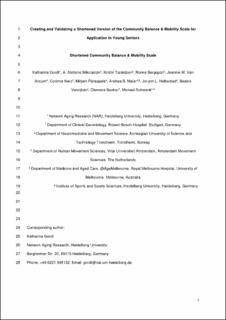| dc.description.abstract | Background
The Community Balance and Mobility Scale (CBM) has been shown to be reliable and valid for detecting subtle balance and mobility deficits in people who are 61 to 70 years of age. However, item redundancy and assessment time call for a shortened version.
Objective
The objective was to create and validate a shortened version of the CBM (s-CBM) without detectable loss of psychometric properties.
Design
This was a cross-sectional study.
Methods
Exploratory factor analysis with data from 189 young seniors (aged 61-70 years; mean [SD] age = 66.3 [2.5] years) was used to create the s-CBM. Sixty-one young seniors (aged 61–70 years; mean [SD] age = 66.5 [2.6] years) were recruited to assess construct validity (Pearson correlation coefficient) by comparing the CBM versions with Fullerton Advance Balance Scale, Timed Up-and-Go, habitual and fast gait speed, 8 Level Balance Scale, 3-m tandem walk, and 30-second chair stand test. Internal consistency (Cronbach α), ceiling effects, and discriminant validity (area under the curve [AUC]) between fallers and nonfallers, and self-reported high and low function (Late-Life Function and Disability Index) and balance confidence (Activities-Specific Balance Confidence Scale), respectively, were calculated.
Results
The s-CBM, consisting of 4 items, correlated excellently with the CBM (r = 0.97). Correlations between s-CBM and other assessments (r = 0.07-0.72), and CBM and other assessments (r = 0.06-0.80) were statistically comparable in 90% of the correlations. Cronbach α was .84 for the s-CBM, and .87 for the CBM. No CBM-version showed ceiling effects. Discriminative ability of the s-CBM was statistically comparable with the CBM (AUC = 0.66-0.75 vs AUC = 0.65-0.79).
Limitations
Longitudinal studies with larger samples should confirm the results and assess the responsiveness for detecting changes over time.
Conclusions
The psychometric properties of the s-CBM were similar to those of the CBM. The s-CBM can be recommended as a valid and quick balance and mobility assessment in young seniors. | en_US |
